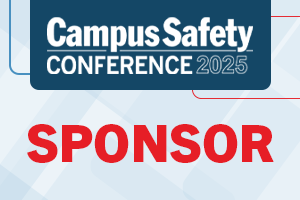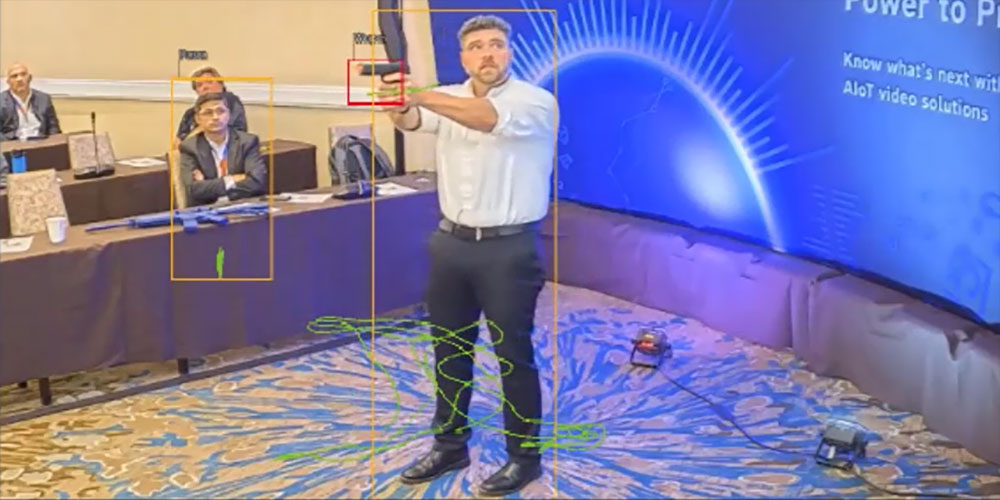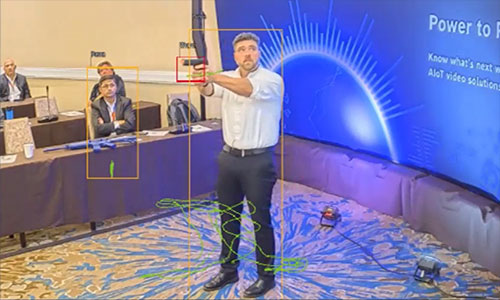In 2021, there were 249 incidents where a firearm was discharged on K-12 campuses – nine active shooter incidents and 240 non-active shooter incidents, according to research by the Center for Homeland Defense and Security.

Bosch is a proud sponsor of this year’s Campus Safety Conference in Austin, Texas, July 21-23. Visit them at the show by registering today at CampusSafetyConference.com!
More recent research from the Washington Post shows over 1,150 guns were seized on K-12 campuses during the 2022-2023 school year, equating to around six guns per day. The same study found that 51 of the country’s largest school districts reported a sharp increase in the number of firearms recovered on campus.
Excluding mass shootings, there were at least 308 instances of gunfire on college campuses from 2013 to 2022, says Everytown for Gun Safety. Resulting in 94 deaths and 115 injuries, these shootings include individual attacks, unintentional gunfire, legal interventions, self-harm, and other instances.
To combat various forms of violence, campuses continue to take a multi-layered approach to school safety, which often includes installing various security technologies. Gunshot detection systems are one of them. As more grant funding is made available to purchase this technology, school leaders are tasked with the challenge of deciding if the technology is right for them and then choosing a solution that best fits their campus’ unique needs.
At the recent Campus Safety Conference at EDspaces, we spoke to Bosch’s Business Development Manager Craig Oberschlake about the company’s gunshot detection system and what he believes sets it apart from others on the market (1:39).
“We are not just looking at gunshot detection — we’re also providing visual gun detection,” Oberschlake told Campus Safety.
When someone brandishing a gun approaches the school, the system is designed to promptly alert personnel who can verify the gun and take proactive measures. If a gun is not visually detected, audio AI — the second layer — is designed to detect and classify gunshots while accurately estimating the direction from which the sound originates. Since the system’s visual and audio layers are camera-based, security staff can always rely on high-quality video footage for forensics supporting first responders, says Oberschlake.
“In addition to that, what sets our gunshot detection apart is the fact that we’re not just looking at a loud noise detector. This is an actual detection system that is comparing sound signatures so that we ensure that we are notifying you that you actually had a gunshot heard in that vicinity of that camera,” he continued. “Schools were getting false notifications off of different things like a textbook slamming to the ground, a door slamming. They don’t want these false notifications because it loses trust in the system. Our sound signature comparison helps them to overcome those fears and ensure that if they get a detection from our system, it’s actually a gunshot.”
In the interview, Craig shares schools’ biggest concerns surrounding the technology (3:25), tips for accessing funding (3:55), and other new developments at Bosch (4:41). He also gives a quick overview of the system which is accompanied by a demonstration of the technology’s visual gun detection capabilities (5:30).
Watch the full interview and demo here or read the transcript below.
Bosch to Display Gunshot Detection System at 2024 Campus Safety Conferences
Are you considering a similar technology and want a more personalized and hands-on demonstration? Bosch will showcase its fully integrated SAFER Solution, which pairs with its visual gun detection and audio gunshot detection, at the 2024 Campus Safety Conference, happening July 8-10 in Atlanta, and again at Campus Safety Conference at EDspaces, taking place Nov. 12-14 in Houston.
For more information on the solution, visit www.boschsecurity.com.

Matthew Cirnigliaro, Regional Marketing Manager at Bosch, demonstrates the company’s visual gun detection technology.
Amy Rock: What sets apart Bosch’s gunshot detection solution from others that are on the market?
Craig Oberschlake: Bosch is coming to the market with a layered solution. So we are not just looking at gunshot detection, we’re also providing visual gun detection. In addition to that, what sets our gunshot detection apart is the fact that we’re not just looking at a loud noise detector. This is an actual detection system that is comparing sound signatures so that we ensure that we are notifying you that you actually had a gunshot heard in that vicinity of that camera.
Amy Rock: Right, because a lot of people hear of a textbook dropping something like that. You don’t want that to pick up because that’s an everyday occurrence that’s always happening.
Craig Oberschlake: Correct. Including a door slamming or even if you have this on the exterior facility, if a car is driving by and happens to backfire, we don’t want to send a notification that there’s a gunshot in any of the instances. We want to make sure that when you get a notification that our camera heard a gunshot, it is a gunshot.
Amy Rock: Right. Fatigue with alarms and everything like that is a really big problem.
Craig Oberschlake: Correct. And so these are things that are going to have a large-scale result. If you go into a lockdown on every single thing that’s heard, even if it’s not a gunshot, people are going to start to ignore it. Kind of like in the old days when you had a fire alarm going off, if it was something that happened all the time, you didn’t respond. We don’t want that. We want people to know that when our system gives you notification that there was a gunshot detected, you are very confident that it was a gunshot.
Amy Rock: Are you finding K-12 schools and colleges are the industries most interested in the technology?
Craig Oberschlake: That was what we started out is taking it to the education facilities – K-12, higher ed — giving them the solution to provide that layer of protection so that they can prevent these tragedies from occurring. As we’ve gone through introducing this system to the world, we’re finding out that this is great in the education environment, but there’s also different verticals out there that like this solution such as retail, corporate offices. So it can be expanded to any campus environment, although K-12 and higher ed is our main focus.
Gunshot Detection Technology Concerns, Accessing Funding
Amy Rock: When working with K-12 campuses or colleges on implementing this technology, what are you finding are their biggest concerns and how does Bosch alleviate those concerns?
Craig Oberschlake: We go back to the sound signature comparison. They were getting false notifications off of different things such as you said, a textbook slamming to the ground, a door slamming. They don’t want these false notifications because it loses trust in the system. So our sound signature comparison helps them to overcome those fears and ensure that if they get a detection from our system, it’s actually a gunshot.
Amy Rock: Do you have any recommendations or tips for accessing funding for this type of technology?
Craig Oberschlake: There is a lot of funding out there right now. There’s different grants, there’s different bonds. You can go federal grants, you can look at state grants. There’s a lot of money that’s being allocated to safety and security of students right now, and it’s a matter of finding a partner that’s going to get you to those funds. We will be offering a grant writing service with one of our partners here in the very near future. We do have other partners that we’re ecosystem partners with as well that currently have those services and we can help direct you to those funds.
Amy Rock: Which is huge because so many schools don’t have a dedicated person to do that, and it’s basically a full-time job to write what these grants are expecting in order to win it.
Craig Oberschlake: Exactly, and you have to be within the parameters of each grant. All of them are different, so you need to understand how do you access those funds, what are the different ways that you can use verbiage to get you as a qualified applicant for those funds.
Amy Rock: Is there anything else new and exciting happening at Bosch that you think Campus Safety readers would be interested in?
Craig Oberschlake: First off, this is my third event with you guys. I’ve been to Vegas, I’ve been to Dallas. I’ve enjoyed it all. We’ve gotten a lot of technology out there. We are getting ready to reintroduce our FLEXIDOME 3000i line to the world, and this is going to be something with our micro-dome cameras. A lot of people are concerned with aesthetics of a camera that goes around a facility. These micro-domes will allow you to have all of the video surveillance that you need without invading people’s privacy, if you will, because they don’t look at them and see them as a camera – they’re looking at them and walking by. So we’re excited to reintroduce that.
We have some bullet cameras that are coming out. We’re also going to be introducing a smaller PTZ camera. Different things are coming. The roadmap is rolling and we’re excited for all of these to hit the market.
Amy Rock: Now are any of those surveillance cameras the dome ones that you’re talking about?
Craig Oberschlake: These aren’t the micro domes, but this is the gun detection system. So you have the two domes which provide the visual gun detection. In our panoramic, you actually have three MIM sensors, which are the audio analytics. This is the camera that actually does the gunshot detection. And so this is our full solution for the gun detection system that you would utilize at an entrance, a vestibule, a choke point so that you can actually get visual detection of the gun. And then if you’re not able to, because of course we have to see it, if they have it concealed, if they end up pulling it out and firing around, then we’re going to capture that through our gunshot detection and our panoramic.
You also get video verification of that because it is a camera and the best part is these are going to provide notifications to the important individuals that need to know this, such as a school resource officer, administrator, whoever’s designated to receive those notifications so that we can actually respond to it faster and hopefully prevent them from ever getting in the school and making sure that we neutralize the threat as soon as possible.













